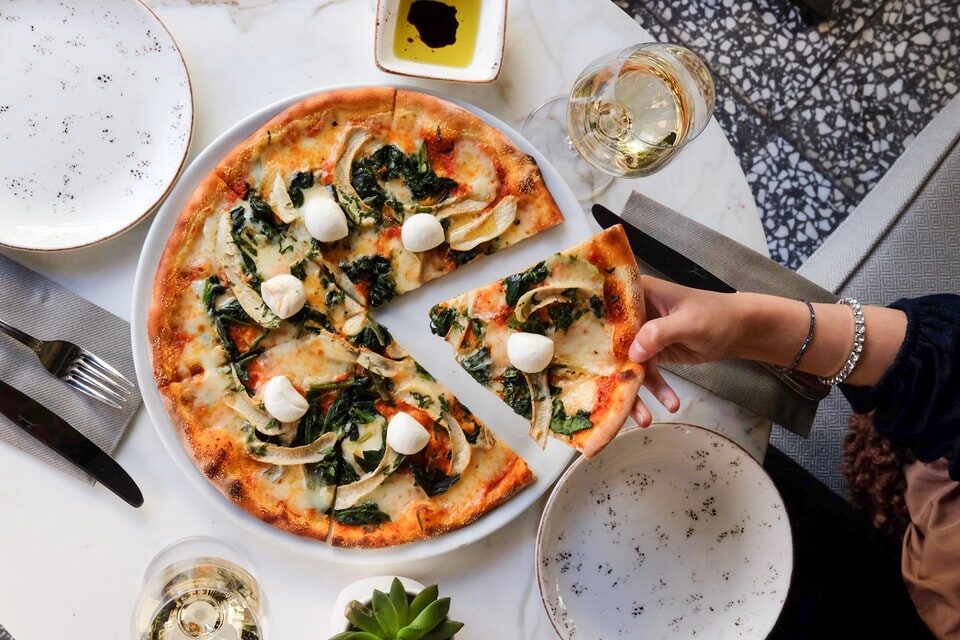With COVID-19 keeping us inside our homes more than we’re used to, some of us may have adopted healthy eating habits that positively impact our wellbeing. We’re eating more fruits and veggies. We’re cooking more of our meals. We’re eating with our families. We’re doing it right when it comes to healthy eating.
And there are some of us who are finding that our eating habits aren’t the greatest. (Raising my hand!) Healthy eating is a low priority.
This global pandemic is a tricky time for everyone. You may be in a household where finances have become a glaring issue. You may be missing your out-of-house workout routine. You may be longing for some in-person social connection. When our lives are turned upside down, we want comfort. We want safety. And for some, that means adopting eating habits that make us feel safe and comfortable.
Maybe you’re like me and your usual eating routine has been put on hold due to all the constant changes going on in other areas of your life. That’s okay. Don’t beat yourself up or feel bad. You’re dealing with a lot of things right now, and likely just trying to get through each day.
But this pandemic won’t last forever, sis. And when it’s over you’ll probably want to get back into incorporating eating habits that optimize your health. Turn wishful thinking about healthy eating habits into a reality with this FREE Healthy Eating SMART Goal template.
Not about weight loss or good foods
A lot of posts about eating and health make people think about dieting, weight loss, and eating more healthy food. Well, that’s not what I’m about. I’ll be upfront: this post is not about weight loss. These tips are not for restricted dieting or calorie deprivation, of which the aim is to lose weight for non-medical reasons. Research shows that such eating habits lead to eventual weight gain when you stop practicing those habits1,3. I’m not saying you’re bad if you have such eating practices. And I’m not saying it’s bad if you want to fit into that smaller dress size! But these tips are not meant to teach you tricks for weight loss. You might shed a few pounds, but that’s not my goal here. These tips are meant to be part of your daily living and help improve your overall health.
These tips are also not part of a specific diet. I’m not here to talk about what are good foods vs bad foods, but rather healthy eating. There are diets (prescription of amount and kind of food for medical reasons) that are necessary. For example, the diabetic diet if you have diabetes. The DASH diet if you have coronary artery disease. In such diets, certain foods will be labeled as healthy food. I’m not about to tell you to categorize food as good foods or section off your food life from the rest of your life. These tips are meant to be incorporated into your eating lifestyle.
So if you’re still with me, below you’ll find three of six simple tips to eat your way to better health.
1. Substitute hunger for thirst
Did you know you’re overall thirstier than you are hungry? That your body yearns for fluids throughout the day more than it does food5? Believe you me, I like to eat. And I used to think that every time my stomach growled or every time I felt a little lightheaded, I needed to get food in my belly. Oh and after finishing a good meal, sometimes I would top it off with a snack because I still felt “hungry”. Well, I’ve learned that’s not always the case. Hunger is not always true hunger for food. Your body might actually be telling you to drink something.
Sis, here’s a suggestion: drink more water.
Good ol’ H2O
What does water have to do with healthy eating? Believe me when I say water is important. The average human adult is made up of 60% water and every cell and organ in your body needs it. Not only is water a great beauty hack for brighter, fresher skin, it is life sustaining. Dehydration leads to poorer concentration, lower energy, loss of strength, and more.
I am not saying don’t eat. Remember, I’m not about dieting. But, what if the next time you thought you were hungry, you drank water instead? The next time you felt lightheaded you guzzled down a glass of water? The next time you filled up on a delicious meal or snack, you finished off with a tall glass of H2O? And then, wait a couple of minutes. See if you’re actually still hungry. You might find that you’re not.
Eat it up
Also, water doesn’t just come in liquid form; we get it in our food too. If you don’t like drinking plain old water, check out Table 1 in this article that breaks down the percent of water in different food items. You can eat your water too!
2. Listen to your body
Infants will let you know when they’re hungry. And they’ll let you know when they’re full. Same with toddlers – at least my toddler sure does with a resounding “nooooo” when he’s not interested in eating or when he’s full, or with a good ol’ slap of his belly when he wants to eat. Babies are really good at listening to their bodies and then telling adults when they want to eat and when they don’t want to eat.
Young children listen to their body’s hunger cues3. They eat what they like and what tastes good to them. Children stop when their body tells them they’re done. Sadly, somewhere along the way of growing up, this beautiful and natural synchronization between the brain and stomach get’s short-circuited. Social pressures. Parents. Daily tasks and responsibilities. These things and more cause people to go from listening to their bodies to ignoring it3. The result? People eating past their hunger cues. People ignoring their hunger cues. People dieting. People starving themselves for the sake of weight loss. This is not healthy eating.
Sis, let’s be like babies again and listen to our bodies when it comes to eating.
Deny, deny, deny
First of all, stop denying yourself food when you’re actually hungry. Could you imagine if a newborn child did that? It’s hard to imagine because they don’t. Please eat when you are actually hungry. There are a lot of diets out there that may ask you to skip meals or to cut down calories in the name of losing weight. But here’s the truth: most people will only lose up to 10% of their body weight through the course of dieting. In the short-term, it seems like you’re losing the weight and being “healthy”.
Gain it all back
Here’s another truth: you will most likely gain all that weight back and then some once you stop that diet1,3. The body sees diets as a famine; it will cooperate in the short-term and shed those pounds. But once you give it food again, the body will want to prepare for another “famine” (ie. diet) and so it will store up all those calories and make it harder to lose weight the next time a “famine” hits. All of that weight loss would have been in vain. So girl, again I say, eat when you’re actually hungry.
Stop at capacity
Babies also eat until they’re full. Their bodies have a natural portion controller switched on. Slowly, as we grow up, that controller malfunctions. It’s important that we don’t overdo it when it comes to the amount of food we eat. The obvious reason is if we consume more calories than we’re using then that leads to becoming overweight and obese, which increases risk of certain chronic diseases and cancer. And those calories can come from any type of food – cake, apples, kale, chips. Again, I am not saying restrict your calories. I am saying eat until you’re satisfied.
Servings vs Portions
For some, the distinction between satisfied and overeating is hard to determine. May I suggest a few things? Slow down your eating – let your brain catch up to your mouth and stomach so that it can tell you sooner when you’re full. Monitor your portions (the amount you choose to eat) in comparison to the recommended serving sizes (the amount suggested you eat of that particular food item) and try to match those up more often than not. Eat fully engaged – get rid of the distractions and focus on eating. When you eat out, pass on the appetizers; when you eat in, buy a size down. And my favourite tip – use a smaller plate; the visual cue will suggest to your body you’re full when you finish because the plate started out full.
If you’re used to eating a lot and eating past feeling full, I recommend making these changes slowly. And also realize that every day will be different. Some days you won’t feel as hungry and some days you’ll want to eat everything in sight. That’s okay, sis. Babies do that too! It’s all part of listening to your body.
3. Enjoy all of your food
I remember growing up and being forced to eat my vegetables. Most of us went through this. We were told that those much disliked veggies were good foods and were good for us. “You can’t have a cookie until you eat your broccoli”. Well, I ate that broccoli, but not because I liked it. In fact, once I moved out of my mom’s house, I stopped eating a lot of “good foods”, “healthy food” because I realized I didn’t really like them… at all. Now, if you saw the way I eat, you’d never guess I don’t like vegetables.
What changed for me? I found a way to enjoy my food.
All the food
I also like burgers and fries, smoothies and oatmeal, cookies and cakes. I like food, period. But when I eat, I make sure what I’m eating is something that will taste good to me. I don’t force myself to eat something if I don’t like it. Sis, don’t force yourself to eat raw onions if you hate raw onions. Why torture yourself? Find ways to prepare food in a way that you like eating it. And don’t feel guilty for eating foods high in sugar and high in fat. They provide fast energy and there’s nothing wrong with that. Should you live off such food? No. Your body also wants sustained energy, protein, vitamins and minerals, which these types of foods don’t provide. So discover ways to enjoy all food more healthily. If that means eating out less often, cooking more of your meals, switching out ingredients, eating less of something and more of something else, do it.
Pancakes with a twist
For example, when I make buttermilk pancakes, I don’t use buttermilk. I use plain yogurt (5-10% fat) and milk mixed with apple cider vinegar to reduce the fat but still get that buttermilk taste. I add a tonne of ground flaxseed for fibre, iron, and healthy fats. I use 60% whole wheat flour and 40% all purpose flour. I add oatmeal because why not? I use 1/3 the amount of sugar, knowing that I’m going to enjoy these pancakes with syrup anyway. Sometimes I add blended black beans or chickpeas because they’re full of protein and iron and don’t change the flavour of the pancakes (although my husband might say otherwise but my son loves his black bean pancakes with peanut butter). All these little changes make for more nutrient dense “buttermilk” pancakes. And I truly enjoy eating them. This is one of many ways I make healthy eating more enjoyable. Find ways to enjoy all food groups more healthily. It’s possible!
(Wanna try those Buttermilk Black Bean Pancakes? Click here!)
Now what?
Want more tips on eating your way to better health? Check out part two of this blog post. If you’re ready to get started on eating for better health, use my Healthy Eating – SMART Goal template where you’ll find the template with all 6 eating tips!
Feel free to leave a comment below sharing how you’re eating your way to better health!
And please like and share this post with your friends!
References
- Blomain, E. S., Dirhan, D. A., Valentino, M. A., Kim, G. W., & Waldman, S. A. (2013). Mechanisms of Weight Regain following Weight Loss. ISRN obesity, 2013, 210524. https://doi.org/10.1155/2013/210524
- Gibney, M. J., Barr, S. I., Bellisle, F., Drewnowski, A., Fagt, S., Livingstone, B., Masset, G., Varela Moreiras, G., Moreno, L. A., Smith, J., Vieux, F., Thielecke, F., & Hopkins, S. (2018). Breakfast in Human Nutrition: The International Breakfast Research Initiative. Nutrients, 10(5), 559. https://doi.org/10.3390/nu10050559
- Hall, K. D., & Kahan, S. (2018). Maintenance of Lost Weight and Long-Term Management of Obesity. The Medical clinics of North America, 102(1), 183–197. https://doi.org/10.1016/j.mcna.2017.08.012
- Hetherington, M. M., Blundell-Birtill, P., Caton, S. J., Cecil, J. E., Evans, C. E., Rolls, B. J., & Tang, T. (2018). Understanding the science of portion control and the art of downsizing. The Proceedings of the Nutrition Society, 77(3), 347–355. https://doi.org/10.1017/S0029665118000435
- Kinsey, A. W., & Ormsbee, M. J. (2015). The health impact of nighttime eating: old and new perspectives. Nutrients, 7(4), 2648–2662. https://doi.org/10.3390/nu7042648
- Mattes R. D. (2010). Hunger and thirst: issues in measurement and prediction of eating and drinking. Physiology & behavior, 100(1), 22–32. https://doi.org/10.1016/j.physbeh.2009.12.026
- Paoli, A., Tinsley, G., Bianco, A., & Moro, T. (2019). The Influence of Meal Frequency and Timing on Health in Humans: The Role of Fasting. Nutrients, 11(4), 719. https://doi.org/10.3390/nu11040719
- Ruddick-Collins, L. C., Johnston, J. D., Morgan, P. J., & Johnstone, A. M. (2018). The Big Breakfast Study: Chrono-nutrition influence on energy expenditure and bodyweight. Nutrition bulletin, 43(2), 174–183. https://doi.org/10.1111/nbu.12323






